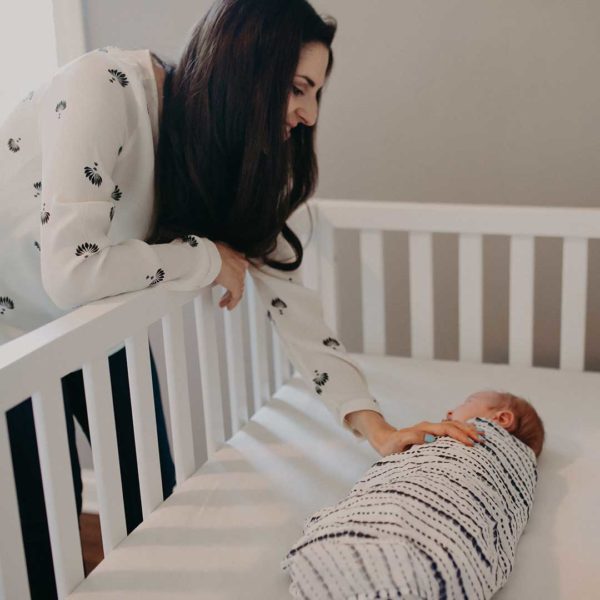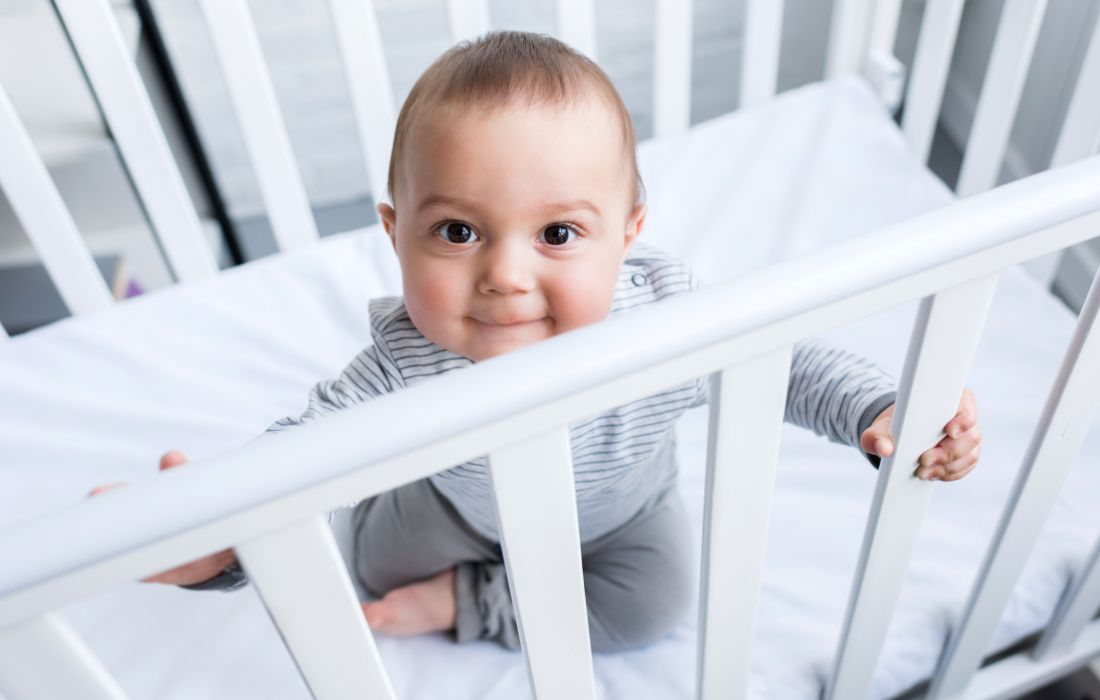Gentle Sleep Training with The Sleep Lady Shuffle
Gentle sleep training — sometimes called sleep coaching — is nothing more than helping your baby learn to put himself to sleep so that he can successfully nap and eventually sleep through the night. Many parents don’t realize that babies do not inherently know how to fall asleep — sleep is a learned skill. When you bring home your infant, you lull them to sleep with just about every activity, since most newborns spend their time either eating, sleeping, or getting a diaper changed. Infants sleep much of the day, as they should.
Once your child reaches six months of age, their sleep patterns change, and you’ll notice that they’re waking for longer periods. Sleep may become a struggle. The good news? Gentle training can help! Learn:
- What are some other sleep training methods?
- What is the Sleep Lady Shuffle?
- When can I start sleep training?
- How do I gently sleep train my baby?
What is the “Ferber” Method?
The phrase “sleep training” causes some parents to shy away from the idea because they automatically think of their baby screaming alone in her crib. This is called the extinction method.
Popularized by Dr. Marc Weissbluth, this method is often associated with Dr. Richard Ferber who actually advocates a modified extinction method where parents check on the baby in timed increments. It does work, but it doesn’t work for everyone. Some parents can’t listen to their baby cry-it-out alone.
What is The Shuffle?
A crying baby causes stress for the whole family — especially baby — which is why many prefer a gentler approach. In parenting, we are the coaches, and our children are in training. Sleep is just one of the many life lessons that we parents need to teach our little ones, and gentle sleep training or coaching will help your baby learn to fall asleep on their own, with minimal crying, and eventually sleep through the night. In fact, many families find that their bedtime issues resolve in as little as two weeks when they stick to their gentle sleep training plan. Please keep in mind that napping, early rising, and night wakings may take a bit longer, and that’s perfectly okay.
Wondering about The Shuffle?
Read a Q&A with Kim: Good Night, Sleep Tight: A Q & A with Kim West, The Sleep Lady
Parents need choices when it comes to sleep coaching. The Shuffle gives families a choice that isn’t cry-it-out or timed checks. This is a sleep coaching method that parents can follow through with consistency.
The gentle sleep coaching process takes both time and patience, but the end result of everyone sleeping is definitely worth a few weeks. Remember, you are essentially teaching your child how to go to sleep and breaking a sleep crutch that he’s had for 6 months or more. So what should you expect when you embark on a gentle sleep training journey?
Have no idea where to begin solving your child’s sleep issues?
Start with this guide.
What is the Best Sleep Training Age?
Babies younger than six months-old are still developing, and really do need to sleep as much as possible. They often don’t have the self-regulating skills and need you to help them. It’s worth noting that some babies who are four to five months-old exhibit signs of being ready to sleep coach, but the majority of babies are not developmentally ready until six months. Once you’ve reached that six-month mark, it’s perfectly okay to begin sleep training, as long as your pediatrician agrees that your baby should be able to sleep through the night and has ruled out any underlying medical conditions.

Gentle Sleep Training with The Shuffle
“The Shuffle” involves providing your child with reassuring, parent-supported, gradual change. This allows your child to find out what helps them fall to sleep on their own. It’s really more like coaching, and it’s a magical process to watch.
When you start your gentle sleep coaching, you will sit by in your chair — literally — and provide verbal and physical reassurance when needed. At the same time you’ll allow your baby to discover whether she likes to rock herself a bit, or prefers to suck her thumb. Your baby might even find a totally different way to soothe herself.
In fact, in the short term, you may find that you are actually getting less sleep. Stick with it! The parental lack of sleep is very temporary, and soon your entire family will be back to sleeping through the night. Remember, it’s a temporary lack of sleep for a long-term solution.
Be Consistent When You Solve Your Child’s Sleep Problems
Babies thrive on consistency. Before you begin to sleep coach your child, make sure that all of the adults involved are on the same page and in agreement. Stick to your guns when it comes to helping your baby sleep. Remember, most babies learn to put themselves peacefully to sleep in just a few weeks.
Expect Some Resistance
Remember, you’re changing how your baby goes to sleep. Gentle sleep training is all about coaching your baby to fall asleep on her own, without your help. Some children go along with the process without much protest, while others complain a bit more. The great part about gentle sleep coaching is that you are present to provide your child with vocal and physical support if needed.
Your Baby Will Probably Cry a Bit
Are you shocked? You shouldn’t be. Crying is a totally normal part of childhood. In fact, for a non-verbal baby, it’s his way of telling you when he wants or needs something. This type of crying is not the same as complete hysteria. Children will often fuss or whimper while they’re getting used to the new routine. And there’s good news: you are there to provide reassurance and help minimize your baby’s frustration so that your baby doesn’t reach that point of hysteria.
If your baby is fussing, pay attention. He may just be working through the problem. If it’s clear that he’s getting more and more upset, then you can step in and help. Remember, you are the coach helping your little one learn to sleep. It’s not something that you can do for him, but you can provide support and encouragement.
When Trouble Arises with Sleep Training
Most families see a positive change in their baby’s (or toddler’s) sleep habits within 7 to 10 days. That’s less than two weeks. Families who don’t see results in the first few weeks generally need to reexamine how they’re doing The Shuffle.
Usually one of three problems:
- A parent has created a new sleep crutch in place of the patting, feeding, or rocking to sleep
- There’s a lack of consistency in response to their child’s awakenings
- There is an underlying medical problem that is contributing to their child’s sleep problem
If you find yourself in this situation, it’s an easy fix, but you may have to backtrack a few days in your Shuffle to make sure that your child is truly learning the skill of putting herself to sleep.
Stick to Your Flexible Schedule
Sleep Training works best when families follow a flexible schedule, meaning that you do you best to stick to regular naps, meals, and bedtimes, with the understanding that sometimes life gets in the way. Do your best to follow your baby’s established schedule, or return to it as soon as possible. The longer the break, the more likely you may have to repeat some of your previous sleep coaching.
Wondering what schedule is best for your baby?
Read: Baby and Child Sleep: Sample Schedules From 6 Months to Preschool
When Life Gets in the Way of Sleep Coaching
Travel, illness, teething, vacations…these are all things that happen to the best of us. If you’re lucky, you’ve planned your travel and vacations, so you can plan ahead and make arrangements for your baby to have a routine as close to the one at home as possible. Remember, it’s all about consistency!

If you find yourself bogged down with an illness or 4 teeth, it’s a bit of a different story. Our children need extra attention when they aren’t feeling well or have a change of location, and with The Shuffle, you can easily take care of those extra night wakings that come with temporary changes. If you get “off track” it’s easy to return to your gentle sleep training roots and backtrack your Shuffle so that your little one remembers that “Oh yes! I know how to do this!”
Need to get back on track?
Read: How to Recover from Sleep Speed Bumps
When all is said and done, you have options other than letting your baby cry-it-out alone in their crib.The Shuffle works 95% of the time as long as you are consistent in your sleep coaching. Your child will learn how to fall asleep without the rocking, patting, feeding, or other crutches that you’ve been using. Then your whole family can finally get some much needed sleep.
Get Good Night, Sleep Tight!
Learn all the details of The Shuffle in Good Night, Sleep Tight. Essential reading for any tired parent, or any expecting parent who wants to avoid the pitfalls of sleeplessness, Good Night, Sleep Tight offers a practical, easy-to-follow remedy that will work for all families in need of nights of peaceful slumber!







